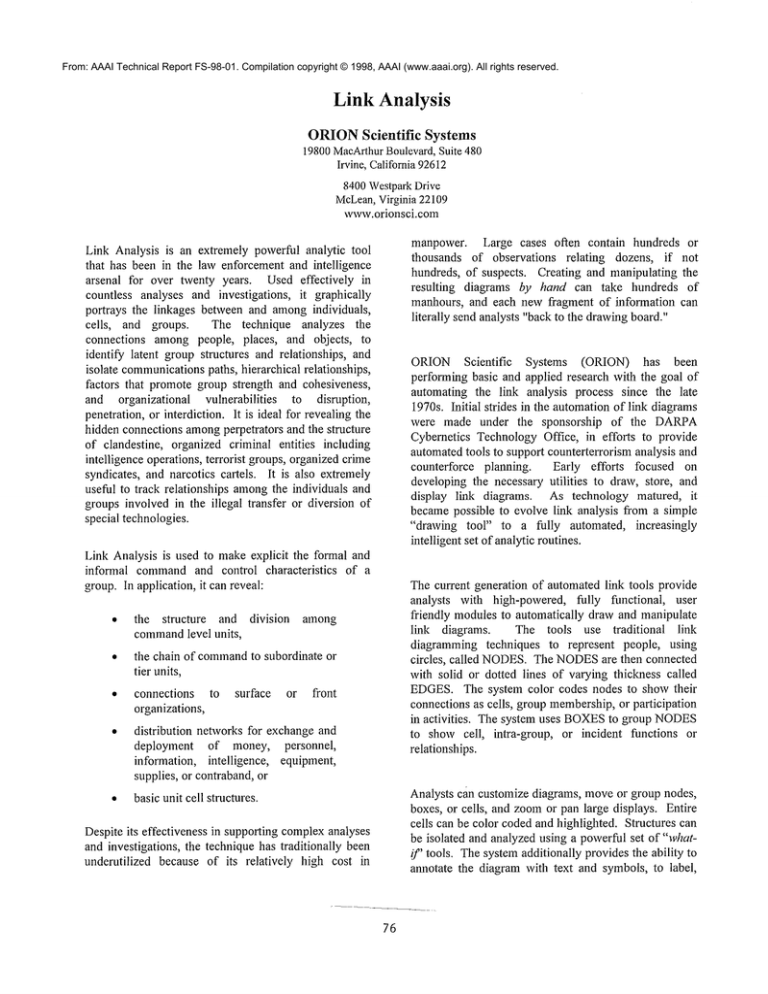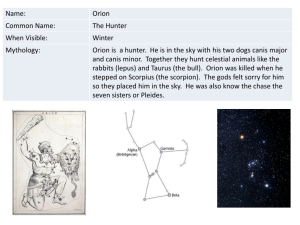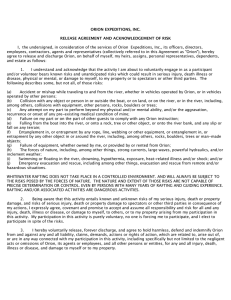
From: AAAI Technical Report FS-98-01. Compilation copyright © 1998, AAAI (www.aaai.org). All rights reserved.
Link Analysis
ORIONScientific
Systems
19800MacArthurBoulevard,Suite 480
Irvine, California92612
8400 WestparkDrive
McLean,Virginia 22109
www.orionsci.com
manpower. Large cases often contain hundreds or
thousands of observations relating dozens, if not
hundreds, of suspects. Creating and manipulating the
resulting diagrams by hand can take hundreds of
manhours, and each new fragment of information can
literally send analysts "backto the drawingboard."
Link Analysis is an extremely powerful analytic tool
that has been in the law enforcement and intelligence
arsenal for over twenty years. Used effectively in
countless analyses and investigations, it graphically
portrays the linkages between and amongindividuals,
cells, and groups.
The technique analyzes the
connections amongpeople, places, and objects, to
identify latent group structures and relationships, and
isolate communications
paths, hierarchical relationships,
factors that promote group strength and cohesiveness,
and organizational vulnerabilities
to disruption,
penetration, or interdiction. It is ideal for revealing the
hidden connections amongperpetrators and the structure
of clandestine, organized criminal entities including
intelligence operations, terrorist groups, organizedcrime
syndicates, and narcotics cartels. It is also extremely
useful to track relationships amongthe individuals and
groups involved in the illegal transfer or diversion of
special technologies.
ORION Scientific
Systems (ORION) has been
performing basic and applied research with the goal of
automating the link analysis process since the late
1970s. Initial strides in the automationof link diagrams
were made under the sponsorship of the DARPA
Cybernetics Technology Office, in efforts to provide
automatedtools to support counterterrorism analysis and
counterforce planning. Early efforts focused on
developing the necessary utilities to draw, store, and
display link diagrams. As technology matured, it
becamepossible to evolve link analysis from a simple
"drawing tool" to a fully automated, increasingly
intelligent set of analytic routines.
Link Analysis is used to makeexplicit the formal and
informal commandand control characteristics
of a
group. In application, it can reveal:
¯
the structure
and division
command
level units,
¯
the chain of command
to subordinate or
tier units,
¯
connections to surface
organizations,
The current generation of automated link tools provide
analysts with high-powered, fully functional, user
friendly modules to automatically draw and manipulate
link diagrams.
The tools use traditional
link
diagramming techniques to represent people, using
circles, called NODES.The NODES
are then connected
with solid or dotted lines of varying thickness called
EDGES.The system color codes nodes to show their
connections as cells, group membership,or participation
in activities.
The system uses BOXESto ~oup NODES
to show cell, intra-group, or incident functions or
relationships.
among
or front
¯ distribution networks for exchange and
deployment of money, personnel,
information, intelligence, equipment,
supplies, or contraband,or
Analysts can customize diagrams, moveor group nodes,
boxes, or cells, and zoomor pan large displays. Entire
cells can be color coded and highlighted. Structures can
be isolated and analyzed using a powerful set of "what/3°’ tools. Thesystemadditionally provides the ability to
annotate the diagram with text and symbols, to label,
¯ basic unit cell structures.
Despite its effectiveness in supporting complexanalyses
and investigations, the technique has traditionally been
underutilized because of its relatively high cost in
76
comment, or draw attention to special relationships
within the diagram. The system also preserves all the
original source data used to produce the diagram, and
makes that data immediately available to the analyst
through a click of the mouse. Thus, the rationale behind
any connection,
and the original
source data to
substantiate any element of the diagram, can be retrieved
and reviewed at any time.
Mr. Eric Zidenbergis a Senior Associatefor ORION.
He managesall
of ORION’s
international client initiatives dealing with ORION
Link
Analysis and related tools. He also managesmultiple statewide
systemsto include the California Department
of Justice system.This
project supports a user groupsupporting over 100 networkedsites
whoutilize the ORION
link analysis tools for gang tracking. Other
clients include the Joint DrugIntelligence Groupin LosAngelesand
Houston.Mr. Zidenberghas workedhand in handwith customersto
develop specialized link and advancedanalytic applications.
Additionally, he has developedand conducted specialized link
analysis training courses. Mr.Zidenberghas a B.S. in Information
Science from Christopher Newport University and a M.S. in
CounselingfromCaliforniaState University.
Another variant of the tool utilizes
a 3D display
technology with full tilt pan and rotate capabilities,
while live in the diagram. This supports analysis of
extremely large and complex data sets, such as those
involved in 100,000 node (and larger) Telephone Toll
analysis investigations.
With rapid expansions in the
size of the data set the link tools can manipulate and the
introduction
of companion
CONCEPT searching
techniques, the tools are increasingly applicable to
"intelligent"
document filtering
for automatic diagram
creation;
money laundering investigations
involving
hundreds
of thousands
of transactions;
and
comprehensive searches of historical electronic message
and file archives.
Ms.BarbaraSkiffington has over 15 years of hands-onexperiencein
applying Artificial Intelligence (AI) and InformationTechnologies
(IT) to projects for the Departmentof Defense (DoD), Federal
governmentagencies, and commercial entities. Technologies
implementedinclude expert systems, neural neP, vorks, database
managementsystems, geographical information systems (GIS),
statistical processing, signal processing, and pattern recognition
algorithms. Ms. Skiffington is ORION’s
ProgramManagerfor the
automationof the NationalReconnaissance
Office personnelsecurity
process. Thisproject integrates the followingtechnologiesrelated to
AI and Link Analysis: 1) AI - Decision aid for the adjudication
decision process, 2) Pattern Recognition- Identification of data
patterns, 3) NeuralNetworks- Decisionprediction aid, and 4) Link
Analysis- Discover),of data relations for the investigativestaff. Ms.
Skiffington received a B.S. in Mathematicsfrom James Madison
University.
Artificial
Intelligence
(AI) provides a fruitful
development path for link analysis tools. Despite the
increasing benefits of automation, link analysis remains
a largely manual process. Automated link tools are still
largely drawing tools. They facilitate
the creation and
manipulation of large diagrams, but their categorization
and analysis are still more art than science and based
more on visualization
than on metrics drawn from the
data points themselves.
AI provides avenues that
promise: 1) greater utility of link diagramming through
detennining
optimal nodal placement
and group
clustering,
and 2) better analysis by identifying and
cataloguing typologies of group or activity structures
which may be used to describe, identify,
and exploit
strengths or weaknesses in group internal structures.
Mr. Craig Wooldridge
is a softwaredeveloperwith over 18 ),ears of
experience. Heis ORION’s
lead programmerin the advancementand
developmentof Web-basedlink analysis products. Mr. Wooldridge’s
expertise lies in advancedsoftwarecodetechnologies,graphicaluser
interface, and databasedesign anddevelopment.Hehas a widerange
of experiencespanningthe developmentof operating systemsto the
development of real-time analytical systems. Mr. Wooldridge
received a B.S. in ComputerScience from the University of
California,anda M.B.A.fromCaliforniaState University.
77







